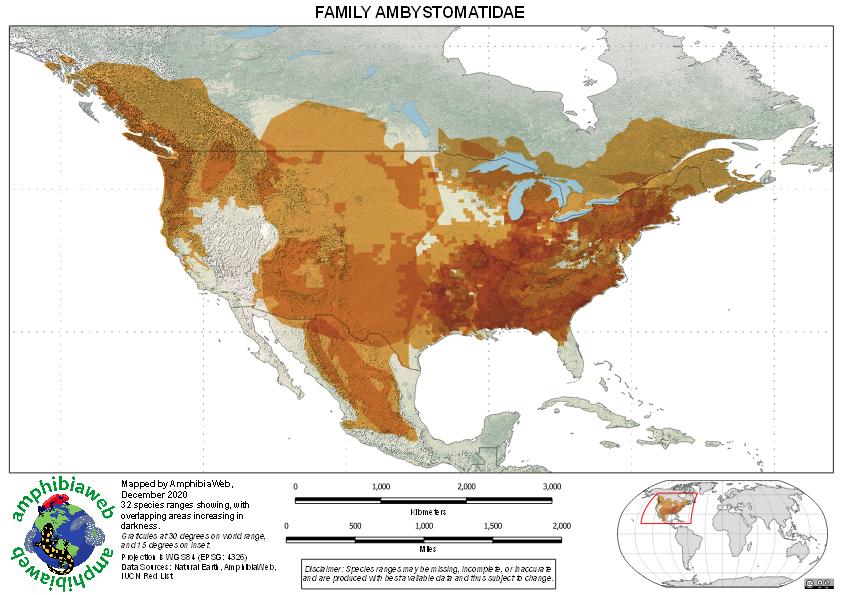Ambystomatidae |
32 species in 1 genus
Commonly Called Mole Salamanders

Ambystoma maculatum
Photo by Nick Scobel
(Click for family gallery)A family of mostly large robust salamanders (up to 340 mm in Ambystoma tigrinum), Mole salamanders are widely distributed in North America, from southern Canada south to Mexico City. These species occur in a variety of habitat, requiring aquatic habitat for their larval stage. This family includes metamorphosing as well as facultative and obligate paedomorphic (maintaining juvenile traits as adults) species, such as the famous Axolotl (Ambystoma mexicanum). Paedomorphs are confined to aquatic habitats and can be induced to metamorphose by the addition of iodine into their habitat. Polyploidy and gynogenetic lineages also occur within this family. The majority of the species in this family spend most of the year underground in rodent burrows and emerge only on rainy nights to mate and feed. Ambystomatid salamanders are famous for the migration of large numbers of individuals to mating ponds.
News Highlight
October 3, 2016: Asexual, parthenogenetic animals are rare, and although they have a short-term selective advantage, they are considered evolutionary dead-ends that should not persist in the long-term. Despite this theory, an asexual lineage of mole salamanders (Ambystoma sp.) has been estimated to have existed for ~5 million years. Cryptic sex has been proposed as an explanation for why this lineage has persisted. Gibbs and Denton (2016) tested this hypothesis using genome-specific microsatellite DNA markers to compare gene flow to asexual females from either sympatric or allopatric males. They determined that relatively high rates of unidirectional gene flow was occurring from sympatric sexual males to asexual females. Their results also indicate the unisexual lineage has a strong selective advantage that prevents the partial genome exchange from sexual males from overwhelming the lineage and causing its extinction. (AChang)Written by AmphibiaWebNotable Family Characteristics
- Medium to large salamanders
- Some morphological characters include: 1) lacrimal bone absent; 2) exoccipitals, prootics, and opisthotics fused; 3) vomerine teeth may be in a transverse orientation in the mouth; 4)costal grooves; 5) well-developed lungs.
- Adults typically live in burrows or talus slopes underground and return to waterbodies or slow streams to breed.
- Includes species which retain juvenile morphology as sexually mature adults, and thus are permanently aquatic (paedomorphic)
- Includes species which exhibit triploidy and gynogenesis (Ambystoma platineum and A. tremblayi, respectively)
- Internal fertilization
- Distributed widely in North America

Cartography Credit: Zoe Yoo, UC Berkeley
Range maps sources: AmphibiaWeb, UC Berkeley, and IUCN RedListRelevant Reference
Blackburn, D. C., and D. B. Wake. 2011. Class Amphibia Gray, 1825. Zhang, Z.-q. ed., Animal biodiversity: An outline of higher-level classification and survey of taxonomic richness. Zootaxa 3148: 39–55.
Vitt, L. J., and J. P. Caldwell. 2013. Herpetology. An Introductory Biology of Amphibians and Reptiles. Fourth Edition. Amsterdam: Elsevier.
Genus Ambystoma (32 species)
Citation: AmphibiaWeb: Information on amphibian biology and conservation. [web application]. Berkeley, California: AmphibiaWeb. Available: https://amphibiaweb.org/. (Accessed:
AmphibiaWeb's policy on data use.
